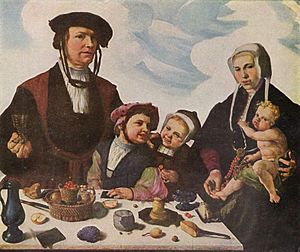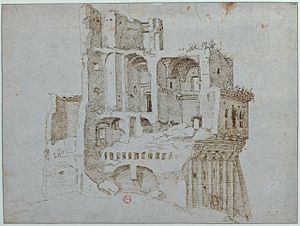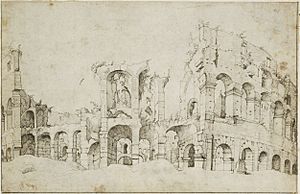Maarten van Heemskerck facts for kids
Quick facts for kids
Maarten van Heemskerck
|
|
|---|---|
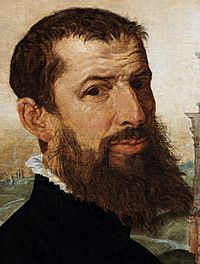
Self-portrait detail from his painting of the Colosseum
|
|
| Born |
Maerten Jacobsz
1 June 1498 |
| Died | 1 October 1574 (aged 76) |
| Nationality | Dutch |
| Known for | Painting |
| Movement | Mannerism |
| Patron(s) | Cornelis Muys, Haarlem council, Delft Council |
Maarten van Heemskerck (born June 1, 1498 – died October 1, 1574) was a famous Dutch painter. He was known for his portraits and religious paintings. Maarten spent most of his life working in Haarlem, a city in the Netherlands. He learned from another artist, Jan van Scorel, and used a painting style that was inspired by Italian art. Heemskerck also lived in Italy for a few years, from 1532 to 1536. He created many drawings that were later turned into prints. He is especially famous for his pictures of the Wonders of the World.
Contents
Maarten van Heemskerck's Life Story
Growing Up and Learning to Paint
Maarten van Heemskerck was born in a small village called Heemskerk in the North Holland area. His father was a farmer. Maarten first started learning to paint in Haarlem. But his father called him back home to help on the farm.
Maarten then had an argument with his father and left home again. This time, he went to Delft to study with another painter, Jan Lucasz. After that, he moved back to Haarlem. There, he became a student of Jan van Scorel. Scorel taught him a new painting style that was influenced by Italian art.
Maarten lived with a rich church leader named Pieter Jan Foppesz. Maarten painted a famous picture of Foppesz and his family. This was one of the first family portraits of its kind in Dutch art. Before he traveled to Italy, Heemskerck painted a scene of St. Luke painting the Virgin for a church in Haarlem.
Travels in Italy
In 1532, Maarten van Heemskerck went on a long trip, sometimes called a "Grand Tour," to Italy. He traveled all over northern and central Italy. He spent time in Rome, where he met important people who helped him.
While in Rome, he made many drawings of old Roman sculptures and buildings. These drawings are still kept in a museum in Berlin today. He used these drawings as ideas for his paintings for the rest of his life. He was the first artist known to draw the famous Capitoline Brutus statue.
Later Career in the Netherlands
Maarten returned to the Netherlands in 1536 and settled back in Haarlem. He became the leader of the Haarlem Guild of Saint Luke in 1540. This was a group for artists. He got married twice, but his first wife and child sadly died during childbirth.
Heemskerck became very successful and earned a lot of money. He painted large altarpieces for churches. He also became a church leader at the Sint-Bavokerk in Haarlem, where he worked for 22 years. In 1572, he moved to Amsterdam to avoid the siege of Haarlem, when Spanish soldiers attacked the city.
Artistic Prints and Engravings
Maarten van Heemskerck was one of the first Dutch artists to make drawings specifically for prints. These drawings were then carved onto metal plates by skilled engravers. This allowed many copies of his artwork to be made and sold.
The Wonders of the World
Heemskerck created drawings for a series of prints that showed the Wonders of the World. Instead of the usual seven wonders, he added an eighth: the Colosseum in Rome. He showed the Colosseum as it looked in his time, in ruins. He also imagined a giant statue of Jupiter inside it. These prints were made by Philip Galle and published in 1572.
-
Colossus of Rhodes, imagined in a 16th-century engraving by Martin Heemskerck
-
Hanging Gardens of Babylon, said to be the oldest-known imaginary reconstruction from historical descriptions
-
The Temple of Artemis, has the "old-fashioned" look of Santa Maria Novella in Florence and other Italian quattrocento churches of the mannerist generation.
-
A fanciful reconstruction of Phidias' Statue of Zeus at Olympia, engraving by Philip Galle in 1572, from a drawing by Heemskerck
-
A fanciful 16th-century interpretation of the Pharos, or Lighthouse of Alexandria
-
The Great Pyramid of Giza (Bettman collection)
-
Fanciful interpretation of the Mausoleum of Halicarnassus, 1572
Heemskerck's Paintings
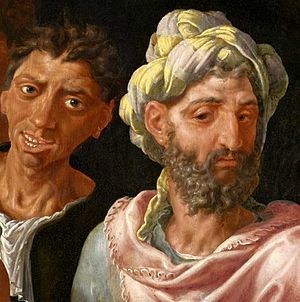

Many of Maarten van Heemskerck's paintings still exist today. His early works include Adam and Eve and St. Luke painting the Likeness of the Virgin and Child. These show his style before he went to Italy.
After returning from Italy, his style changed. He studied the works of famous Italian artists like Michelangelo and Raphael. However, he never forgot his Dutch roots. His paintings often show strong muscles and detailed buildings.
One important work is an altarpiece for a church in Alkmaar, painted between 1539 and 1543. Another is a Crucifixion for a church in Ghent from 1543. He also painted an altarpiece for the Drapers' Company in Haarlem, finished in 1546.
In 1550, Heemskerck painted a large triptych (a painting with three panels). Parts of it are now in different museums. He also painted a copy of Raphael's Madonna of Loreto in 1551. In 1552, he painted a scene of a bull race inside the Colosseum in Rome.
His painting Judgment of Momus from 1561 shows his knowledge of human anatomy. Other works can be found in museums around the world, including the Hermitage Museum in Russia and galleries in Vienna, Rotterdam, and Munich.
Parrots in Paintings
Maarten van Heemskerck painted a scene called Saint Luke painting the Virgin twice. He made these paintings for groups of painters. In both paintings, he included a parrot. In the first painting, the parrot was in a cage at the top. However, that part of the painting was cut off and is no longer visible. In the second painting, the baby Jesus holds the parrot.
Maarten van Heemskerck's Death
Maarten van Heemskerck died on October 1, 1574. He had lived a long and successful life and had become quite wealthy. He left money and land to an orphanage in Haarlem. He also made a special request in his will. He wanted money to be paid each year to any couple who got married on his tombstone in the Haarlem cathedral. People at the time believed this would bring peace to the dead.
His Artistic Reputation
Maarten van Heemskerck was highly respected during his lifetime. He greatly influenced other painters in Haarlem. He is known for bringing Italian art styles to the Northern Netherlands. His series of prints showing the Wonders of the World helped spread his fame. A writer named Karel van Mander wrote a long biography about him in his book about artists.
Where to See His Art
You can find Maarten van Heemskerck's paintings and drawings in many public collections around the world, including:
- Courtauld Institute of Art
- Museum Boijmans Van Beuningen, Rotterdam
- Museum of New Zealand Te Papa Tongarewa
- National Gallery, London
- Rijksmuseum Amsterdam
- Musée des Beaux-Arts de Strasbourg
- University of Michigan Museum of Art
- Museo Municipal de Bellas Artes Juan B. Castagnino, Rosario
See also
 In Spanish: Maarten van Heemskerck para niños
In Spanish: Maarten van Heemskerck para niños


